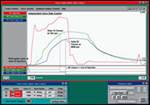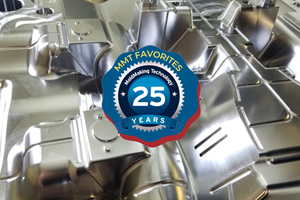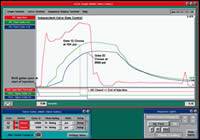Part One of a Two-Part Series Valve Gate Sequencing Strategies
Ways to use valve gate control strategies to improve quality, efficiency and profitability
Toolmakers and injection molders worldwide are being squeezed for lower costs, absolute quality parts and reduced turnaround times, and new technologies and techniques are the key to conquering these industry challenges. Molders don't want to waste material on a hot sprue bushing or a hot runner system as this drives up the cost of the mold, and the use of regrind is both costly and generally limited by customer specifications. If a mold builder's customer has a machine that does not appear to be large enough to support the clamp force, although they do have enough shot size, an opportunity exists for the mold builder to present a strategy that will allow the molder to produce the parts he requires.
An opportunity exists to improve productivity and quality for the molder, by using valve gate sequencing technology in conjunction with hot runner systems. While hot runner molding is a proven technology for reducing waste, without additional technologies in place, they are oftentimes the cause of variation. Simple timed valve gates simultaneously opening and closing will not provide the advantage of control unless coupled with cavity pressure and sequencing technology. This article will explore other alternatives that actually control each gate independently in a way that process consistency can approach that of a single cavity, single flow front process.
It is commonly accepted that optimum consistency can be achieved with a single cavity mold with one gate. The injection unit controls a process with only one flow front. Therefore, repeatability of the speed and direction of flow in the mold is predetermined. In most cases, however, with any high volume application, the paradigm of single cavity, single flow is not one that is readily acceptable from a cost perspective for the toolmaker or the molder. Multiple cavity molds with conventional runners generally can be tuned. However, in hot runner tools where there are multiple parallel flow paths of melted plastic in the manifold, fill inconsistencies over time can cause a number of problems, such as short shots, flash, dimensional variations, warp, sink and knit-line inconsistencies. All of these add up to problems with quality and consistency that oftentimes make these hot runner molds more problematic than the molds they replaced.
In addition, process costs are generally machine size related. The ability to run more parts with presses of smaller tonnage is another opportunity for cost savings. In this regard, stack mold technology has been utilized. This has increased the complexity of the balance problem and has significantly added to the complexity and size of the tools. Another approach is alternate cavity valve gate control, which can utilize existing valve gated molds with a process to sequentially or independently fill the cavities, which can also reduce the clamp force needed to produce the same parts.
This two part series will discuss ways of using valve gate control strategies to improve quality, efficiency and profitability. There are three types of valve gate control commonly used: independent, alternate and sequential control.
Independent Valve Gate Control
An independent valve gate control sequence is shown in Figure 1. When the process is initiated, all cavities start filling, generally at the start of injection when all valve gates are opened. Parts can be identical, as in the case of multicavity molds, or different sizes or shapes as in a family mold.
In this situation, flow is allowed into each cavity and is initiated in parallel. Any flow imbalances are essentially disregarded. Each cavity is equipped with a cavity pressure sensor, generally in the first area of fill, to measure pressures and determine the amount of packing required in the mold. During the filling process, early cavities may become packed prior to other cavities being filled. In this situation, a cavity pressure sensor with an individual set point for each cavity is used. When the pressure setting is reached the valve gate closes—allowing the material to be held in the cavity while cooling takes place. Cavity sensing and control is done independently so when all cavities are packed, injection pressure is terminated and the cycle is completed conventionally.
In addition to controlling pack pressure, control of filling is often required in family molds. This is particularly true with cavities that vary in size. To ensure a reasonably balanced fill, the gates may be opened at different times based on the volume injected into the cavity. As the screw begins to inject, only some cavities will be open. As the larger cavities fill, smaller ones open at certain screw positions during injection. This can prevent a small cavity from filling too soon and ensure that all cavities begin to pack at the same time. This technique can be especially important for items like toys that have several different parts that require the color to match for one finished assembly.
Controlled Discharge Approach
Another technique in individual valve gate control is the controlled discharge approach. In this situation, each cavity is packed above the cavity pressure set point and once all cavity pressures have been reached, the injection speed is terminated with the valve gates open. Once the cavity pressure drops back below the set point, the valve gates are closed. This provides the ability to highly pack a part and then control the effective cavity pressure by discharging. This is especially useful on center gated parts where over-packing near the gate causes warp.
The independent valve gate control can be an effective tool to cure what is called multiprocess disease. When multiprocess disease is present in a mold, cavities are essentially independent processes because of the changes in the fill patterns between cavities over time.
Retrofitting existing molds requires a simple adaptation of the mold to allow hydraulic separation of each of the valve gate pistons, so that they can be controlled independently. Once this is done, independent valve gate control can be easily implemented and there should be no cycle time penalties.
In the next article we will look at alternate and sequential control strategies using valve gates in that new mold instead of a cold runner.
Correction:
In regards to the Gary Chastain's (RJG, Inc.) article entitled "Achieving Cavity Balance: Another Factor for Success", Beaumont Technologies, Inc. (BTI) was named as a reference, from which they appear to endorse the information contained in the article. While BTI and RJG work together in various aspects of molding technologies, BTI did not contribute to, review, or endorse the information in the article regarding the cause of shear-induced filling imbalances and the suggestion that radiused runners solve those imbalances. The opinions presented in that article are solely that of RJG. Though BTI and RJG may differ as to the root cause of the problem, RJG firmly supports Beaumont Technologies' MeltFlipper® melt management systems and acknowledge that the technologies provided by BTI work well and are an excellent solution for solving mold imbalance issues.
Related Content
Leading Mold Manufacturers Share Best Practices for Improving Efficiency
Precise Tooling Solutions, X-Cell Tool and Mold, M&M Tool and Mold, Ameritech Die & Mold, and Cavalier Tool & Manufacturing, sit down for a fast-paced Q&A focused on strategies for improving efficiencies across their operations.
Read MoreDynamic Tool Corporation – Creating the Team to Move Moldmaking Into the Future
For 40+ years, Dynamic Tool Corp. has offered precision tooling, emphasizing education, mentoring and innovation. The company is committed to excellence, integrity, safety and customer service, as well as inspiring growth and quality in manufacturing.
Read MoreMMT Chats: The Connection Between Additive Manufacturing Education and ROI
This MMT Chat continues the conversation with Action Mold and Machining, as two members of the Additive Manufacturing team dig a little deeper into AM education, AM’s return on investment and the facility and equipment requirements to implement AM properly.
Read MoreMMT Chats: Eliminating the Noise to Stay Focused on the Customer
Metro Mold & Design joins me to discuss the value of the 80/20 rule as a business strategy, its talented cross-functional team, the role of automation in mold building and molding, and the continuing impact of COVID-19.
Read MoreRead Next
Part Two of a Two-Part Series Valve Gate Sequencing Strategies
More valve gate strategies and how they help moldmakers and molders work together to develop a mold that will provide the most consistent performance.
Read MoreHow to Use Continuing Education to Remain Competitive in Moldmaking
Continued training helps moldmakers make tooling decisions and properly use the latest cutting tool to efficiently machine high-quality molds.
Read MoreAre You a Moldmaker Considering 3D Printing? Consider the 3D Printing Workshop at NPE2024
Presentations will cover 3D printing for mold tooling, material innovation, product development, bridge production and full-scale, high-volume additive manufacturing.
Read More



















